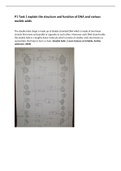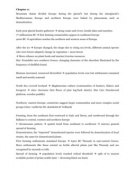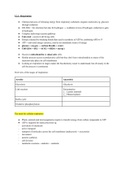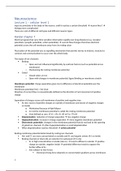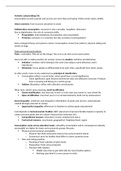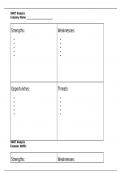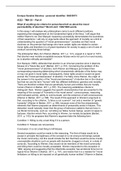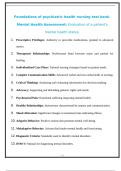OF
PHARMACOLOGY
4BBY1040
Drug Effects and Treatment on
the Cardiovascular and
Respiratory System
,LECTURE 14:
Smooth muscle:
Location: Wall of hollow organs, including blood vessels (except for capillaries)
Function: To act as the body’s conduits for the transport of gases, liquids and
solids.
Morphology: Cells not striated, worm shaped organs
Regulation: By the ANS and by hormones and locally released substances. In GI
tract rhythmic contractions are initiated by pacemaker cells
Blood vessels Controls diameter, vascular Vasodilator
resistance, distribution of blood
flow and blood pressure, also
venousn capacitance and central
venous pressure
Gastrointestina Controls mixing and propulsion Spasmolytics: anti-muscarinis
l tract of GI contents (IBS)
Respiratory Controls diameter of airways Bronchodilators (ß2 agonists:
system salbutamol)
Uterus Mediates labor Labour inducers (oxytocin)
Bladder, Controls urine storage and Anti-muscarinics and ß3 agonists
ureters, micturition to treat LUTS. (PDE inhibitors for
urethra erectile disfuction and LUTS)
Vas deferens Controls erection and ejaculation
and corpus
cavernosum
Fallopian tube Mediates movement of eggs
from ovaries to uterus
Iris and ciliary Controls pupil diameter and
body focusing of the lens
Drugs which affect SM function:
- Drugs which block or stimulate receptor (anti-muscarinis, ß2, ß3 agonists)
- Drugs acting on smooth muscle cell signal transduction (Ca2+ channel
blockers, K+ channel openers)
Cardiovascular disease
Vascular tone is the result of a balance between various constricting and dilating
influences:
- Sympathetic nerve fibres from the tunica adventive release noradrenaline.
- Blood borne substances such as angiotensin 2 and adrenaline (Adrenaline
can constrict (alpha receptors) or relaxed (ß2 receptors))
- Increases in pressure can cause arterial contraction (myogenic
contraction)
- Tissue metabolites / Local hormones (can also make endothelium release
more NO)
- Vasodilation (relaxation) is mainly caused by NO, that is forced out of
endothelium by blood flow
, Structural features of smooth muscle:
Contraction involves cross bridges of myosin and actin. Myofilaments have no Z
lines and run along the axis of the cell, they are attached to dense bodies,
connected by intermediate dilaments.
Adherens junctions attach the smooth muscle cells with each other.
Disorganized arrangement of cytoskeleton and network of filaments allow for SM
to contract by 2/3 (the most of the muscle cells)
Sarcoplasmic reticulum consists of network of sacks and vesicles that release
and reaccumulate Ca2+.
Gap junctions allow current to be passed through cells, allowing for contraction
coordination.
Regulation of smooth muscle contraction:
As Ca2+ concentration increases it binds to Calmodulin (4 times), promoting the
binding with myosin light chain kinase to make active complexes.
This active complexes phosphorylates myosin. Phosphorylated myosin forms
crossbridges with actin. All in a balance with myosin phosphatase, that
dephosphorylates myosin.
During relaxation Ca2+ concentration decreases and therefore myosin
phosphatase will preferably inhibit cross bridge formation.
Vasoconstrictors inhibit myosin phosphatase so any formation of the
active complex will have a greater effect and the muscle will contract
(Noradrenalin)
Done by indirectly stimulating rho kinase (deactivates myosin phosphatase) –
Ca2+ sensitization. (promotes contraction)
Myosin phosphatase activated by NO via cGMP – Ca2+ desensitization,
promoting relaxation
Noradrenaline vessel constriction
Vasodilation mainly caused by Nitric oxide (NO) that is release by blood flow but
also released by: ATP, histamine, H+, CO2, and ACh, causing the relaxation of
the surrounding smooth muscle. Used to treat:
Hypertension: High BP = CO · TPR (reduced by lowering resistance)


